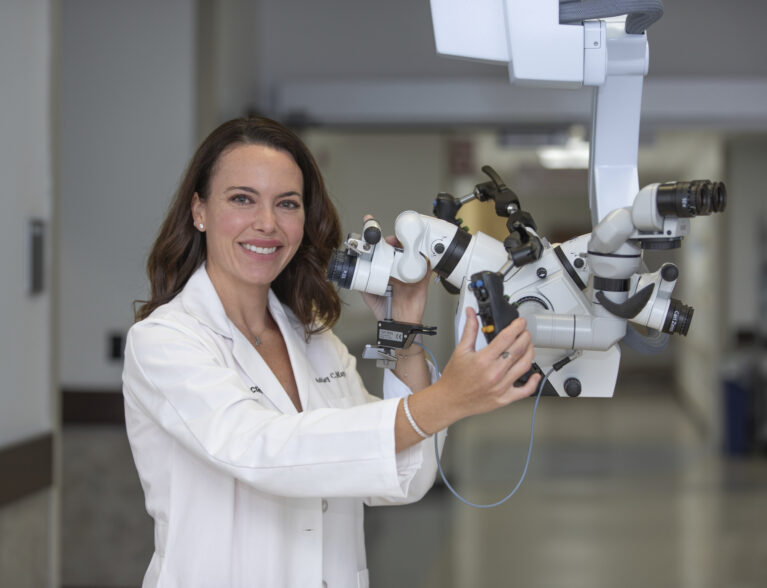
Most of us brush off a scratchy throat, a hoarse voice, or a persistent earache as just another nuisance – an allergy, a cold, maybe the weather. But sometimes, these seemingly minor symptoms are your body’s alarm bells, warning of something far more serious – cancer.
Head and neck cancers are a group of malignancies that can arise in the nasal cavity, sinuses, lips, mouth, salivary glands, throat or larynx. They typically begin in the squamous cells that line the moist surfaces inside the mouth, nose and throat.
In 2024, these cancers made up about 4 percent of all cancer diagnoses in the United States. The National Cancer Institute estimates that approximately 71,100 people were diagnosed with cancers of the oral cavity, pharynx or larynx last year. And that more than 16,000 people died from these diseases.
“Head and neck cancer is a very broad terminology,” said Dr. Ashley C. Mays, an otorhinolaryngologist at Cleveland Clinic Indian River Hospital. “We literally treat everything from the bottom of the skull all the way down to the collarbone. Think about how many structures that is – it’s the nose, sinuses, skin, tongue, throat, salivary glands, thyroid and parathyroid glands. Each of those parts has its own cancers, and not all head and neck cancers are created equal.”
According to Dr. Mays, skin cancer is the most common type affecting the head and neck, although many small skin cancers are treated by dermatologists before ever reaching a surgeon’s office. Among non-skin-related cancers, mucosal cancers – those affecting the lips, tongue, throat and voice box – are the most frequent.
Most mucosal cancers are linked to smoking, alcohol use or a weakened immune system. Human papillomavirus (HPV) has also emerged as a major risk factor, though it is primarily associated with oropharyngeal cancers that develop in the back of the throat, including the tonsils and base of the tongue.
Other risk factors include prolonged sun exposure (for lip and skin cancers), poor oral hygiene, and occupational exposure to wood dust, paint fumes or industrial chemicals. Genetic predisposition plays more of a role in endocrine-related cancers, such as those of the thyroid or parathyroid glands.
Early symptoms can be subtle and are often mistaken for less serious conditions. These include:
- Persistent sore throat or hoarseness
- A lump in the throat or neck
- Unexplained weight loss
- Mouth sores
- Chronic ear pain
- Nasal congestion or bleeding
“Oral cancers are often painful, and the mouth is an easy place to inspect,” Dr. Mays said. “If you notice a sore that doesn’t heal, that’s a warning sign.”
Throat or ear pain is another red flag – particularly if ear pain persists despite treatment. “The pain might be referred from the throat, not the ear itself,” she explained. “If ear drops or antibiotics don’t work, ask your primary care doctor for a referral to an ENT specialist.”
For men, a telltale sign may appear while shaving. “Many patients notice a lump in the neck,” Dr. Mays said. “Unfortunately, that’s often a sign the cancer has already spread to a lymph node.
Immediate medical attention is critical.”
Diagnosing head and neck cancers typically involves a physical exam, imaging (CT, MRI or PET scans) and biopsy. Treatment plans depend on the type, location and stage of the cancer and may include surgery, radiation, chemotherapy, targeted therapy or immunotherapy.
Because the head and neck are involved in vital daily functions – breathing, speaking, swallowing and eating – treatment decisions aren’t just about removing cancer, but preserving quality of life.
“While surgery might be the most straightforward option, it may not be the most functional,” Dr. Mays said. “For example, removing a portion of the tongue might cure the cancer, but it could permanently affect a patient’s ability to speak or swallow.”
That’s why non-surgical approaches are often considered first for certain tumors, while surgery remains the best lifesaving option for others – such as skin, salivary gland, and thyroid cancers.
After major surgery, patients may need extensive reconstruction and rehabilitation. Some are left disfigured and face the challenge of relearning to speak or swallow.
“I’m the reconstruction surgeon for this whole area,” Dr. Mays said. “My job is not only to remove the cancer but to make that person whole again – whether it’s rebuilding their tongue, nose, jaw or throat.”
Trained at MD Anderson, one of the nation’s top cancer centers, Dr. Mays and her team at Indian River Hospital perform complex transplant and reconstruction procedures on par with leading academic hospitals.
According to the NCI, about 69 percent of patients diagnosed with oral cavity or pharyngeal cancer survive five years or more, while the five-year survival rate for laryngeal cancer is about 61 percent. With early detection, the five-year survival rate for some head and neck cancers can reach 80 percent to 90 percent, according to the American Cancer Society.
“The key is to be proactive and listen to your body,” Dr. Mays says. “Don’t ignore persistent pain or discomfort. A sore throat may be warning you about something far more serious.”
Dr. Ashley Mays received her medical education at the Brody School of Medicine at East Carolina University in Greenville, North Carolina, and completed her otolaryngology residency at Wake Forest University in Winston-Salem, North Carolina. She also completed a two-year fellowship in head and neck surgical oncology and microvascular reconstruction at University of Texas MD Anderson Cancer Center in Houston. She is the Co-Director of Surgical Operations at Cleveland Clinic Indian River Hospital and the Regional Director of Quality for the Integrated Surgical Institute for Cleveland Clinic Florida. Her office is in the Scully-Welsh Cancer Center at Cleveland Clinic Indian River Hospital. Call 877-463-2010 for an appointment.



